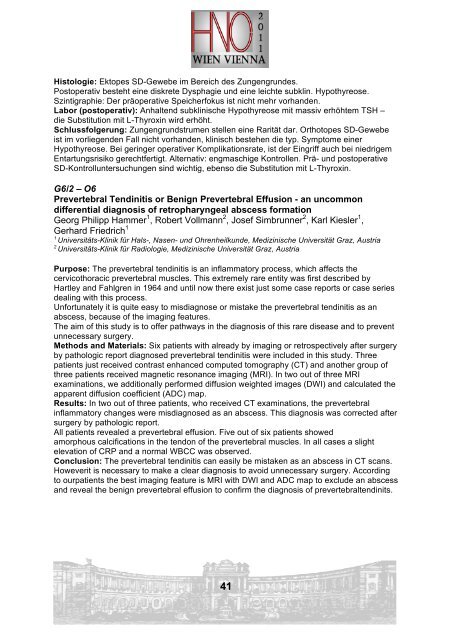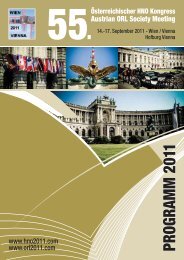Abstractbook als PDF downloaden - hno kongress 2011
Abstractbook als PDF downloaden - hno kongress 2011
Abstractbook als PDF downloaden - hno kongress 2011
Sie wollen auch ein ePaper? Erhöhen Sie die Reichweite Ihrer Titel.
YUMPU macht aus Druck-PDFs automatisch weboptimierte ePaper, die Google liebt.
Histologie: Ektopes SD-Gewebe im Bereich des Zungengrundes.<br />
Postoperativ besteht eine diskrete Dysphagie und eine leichte subklin. Hypothyreose.<br />
Szintigraphie: Der präoperative Speicherfokus ist nicht mehr vorhanden.<br />
Labor (postoperativ): Anhaltend subklinische Hypothyreose mit massiv erhöhtem TSH –<br />
die Substitution mit L-Thyroxin wird erhöht.<br />
Schlussfolgerung: Zungengrundstrumen stellen eine Rarität dar. Orthotopes SD-Gewebe<br />
ist im vorliegenden Fall nicht vorhanden, klinisch bestehen die typ. Symptome einer<br />
Hypothyreose. Bei geringer operativer Komplikationsrate, ist der Eingriff auch bei niedrigem<br />
Entartungsrisiko gerechtfertigt. Alternativ: engmaschige Kontrollen. Prä- und postoperative<br />
SD-Kontrolluntersuchungen sind wichtig, ebenso die Substitution mit L-Thyroxin.<br />
G6/2 – O6<br />
Prevertebral Tendinitis or Benign Prevertebral Effusion - an uncommon<br />
differential diagnosis of retropharyngeal abscess formation<br />
Georg Philipp Hammer 1 , Robert Vollmann 2 , Josef Simbrunner 2 , Karl Kiesler 1 ,<br />
Gerhard Friedrich 1<br />
1<br />
Universitäts-Klinik für H<strong>als</strong>-, Nasen- und Ohrenheilkunde, Medizinische Universität Graz, Austria<br />
2<br />
Universitäts-Klinik für Radiologie, Medizinische Universität Graz, Austria<br />
Purpose: The prevertebral tendinitis is an inflammatory process, which affects the<br />
cervicothoracic prevertebral muscles. This extremely rare entity was first described by<br />
Hartley and Fahlgren in 1964 and until now there exist just some case reports or case series<br />
dealing with this process.<br />
Unfortunately it is quite easy to misdiagnose or mistake the prevertebral tendinitis as an<br />
abscess, because of the imaging features.<br />
The aim of this study is to offer pathways in the diagnosis of this rare disease and to prevent<br />
unnecessary surgery.<br />
Methods and Materi<strong>als</strong>: Six patients with already by imaging or retrospectively after surgery<br />
by pathologic report diagnosed prevertebral tendinitis were included in this study. Three<br />
patients just received contrast enhanced computed tomography (CT) and another group of<br />
three patients received magnetic resonance imaging (MRI). In two out of three MRI<br />
examinations, we additionally performed diffusion weighted images (DWI) and calculated the<br />
apparent diffusion coefficient (ADC) map.<br />
Results: In two out of three patients, who received CT examinations, the prevertebral<br />
inflammatory changes were misdiagnosed as an abscess. This diagnosis was corrected after<br />
surgery by pathologic report.<br />
All patients revealed a prevertebral effusion. Five out of six patients showed<br />
amorphous calcifications in the tendon of the prevertebral muscles. In all cases a slight<br />
elevation of CRP and a normal WBCC was observed.<br />
Conclusion: The prevertebral tendinitis can easily be mistaken as an abscess in CT scans.<br />
Howeverit is necessary to make a clear diagnosis to avoid unnecessary surgery. According<br />
to ourpatients the best imaging feature is MRI with DWI and ADC map to exclude an abscess<br />
and reveal the benign prevertebral effusion to confirm the diagnosis of prevertebraltendinits.<br />
41



